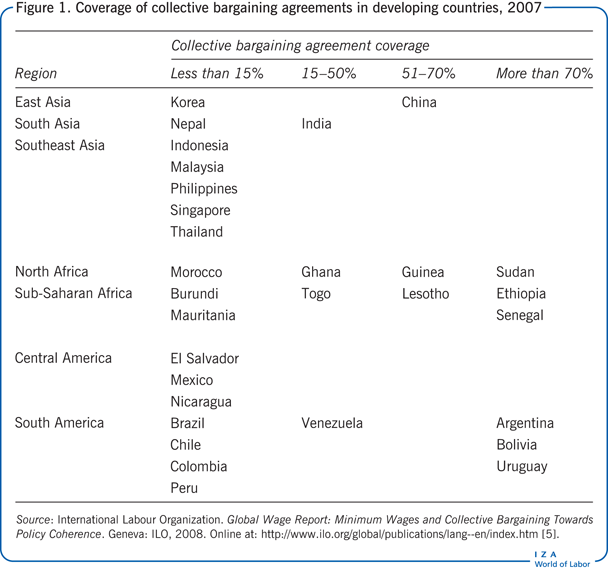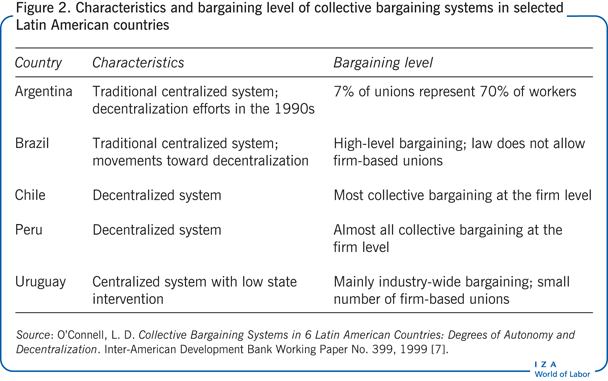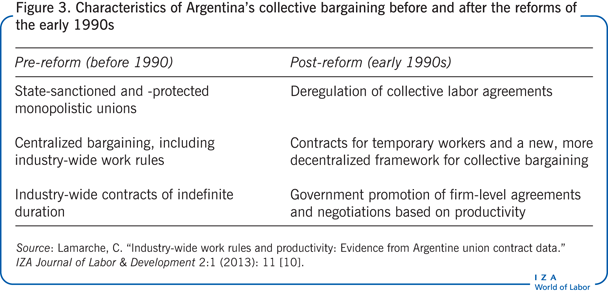Elevator pitch
Because theoretical arguments differ on the economic impact of collective bargaining agreements in developing countries, empirical studies are needed to provide greater clarity. Recent empirical studies for some Latin American countries have examined whether industry- or firm-level collective bargaining is more advantageous for productivity growth. Although differences in labor market institutions and in coverage of collective bargaining agreements limit the generalizability of the findings, studies suggest that work rules may raise productivity when negotiated at the firm level but may sometimes lower productivity when negotiated at the industry level.
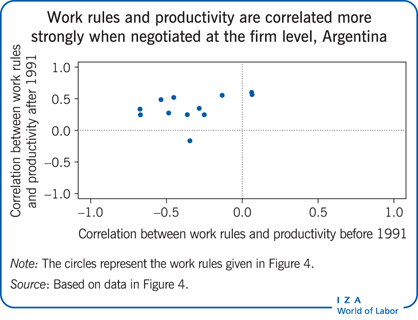
Key findings
Pros
Latin American countries that have reformed their labor institutions offer a unique opportunity to understand how changes in collective bargaining affect economic output.
The coverage and level of negotiations of collective bargaining agreements are important determinants of the association between negotiated work practices and labor productivity.
Firm-level negotiations, in general, promote productivity increases in developing countries.
In some developing countries, collective bargaining has remained fairly stable over time, with some tendency toward decentralization.
Cons
Labor market institutions, economic conditions, and collective bargaining coverage and negotiation levels vary across developing countries, making generalization difficult.
Industry-level bargaining may lower productivity by restricting managerial flexibility in response to market changes.
Weak representation of employers in collective bargaining may affect the coverage and outcome of collective bargaining.
Empirical evidence is more extensive on the effect of collective bargaining on wages than on productivity.
Author's main message
Developing countries have a long tradition of determining wages and working arrangements through industry-wide collective bargaining agreements. While the evidence on the effect of union contracts on wages is abundant, the cross-country evidence associated with the effect of work practices on productivity is limited. Several empirical studies suggest that economies benefit from productivity increases from work rules negotiated at firm level. However, collective bargaining agreements and economic conditions vary widely across developing countries restricting support for any single generalization.
Motivation
Economic theory differs on the economic impact of collective bargaining. One standard argument is that unions can increase productivity in the workplace by collaborating with management in the search for better practices [1]. Another argument counters that unions can impose inefficient work rules, such us restrictions on laying off workers when technology changes, which reduce productivity and even affect workers who are not represented by unions. While the theoretical arguments come down on both sides of the issue, the empirical evidence for developing countries on what practices are most frequently bargained collectively, who is covered by collective bargaining agreements, and what effect work rules have on labor productivity is just beginning to emerge.
This paper looks at both sides of the collective bargaining issue in developing countries. It focuses on the empirical evidence on trends, levels of negotiation, and coverage of agreements. While differences between Latin American countries and developing countries in Asia and Africa are discussed, the main focus is on the lessons of the weakening of industry-wide collective bargaining in Argentina in the early 1990s in favor of firm-level bargaining. The paper concentrates on analyses of the most important working practices included in labor contracts. Understanding the effects of these practices is crucial for designing government policies and regulations.
Discussion of pros and cons
Labor institutions in developing countries
Research is abundant on labor institutions in developed countries with stable institutions, such as the US and Western European countries. The literature is much sparser on labor market institutions and economic outcomes outside the Western world and in less developed economies. Since the early 1990s, however, the study of institutions and policies in developing countries has increased dramatically. These studies can illuminate how institutions affect outcomes in general and productivity in particular in developing countries [2].
The theoretical picture is ambiguous. On the one hand, unions might impose inefficient work rules through collective bargaining that unduly restrict managerial discretion and reduce firms’ flexibility in reacting to market conditions, thus increasing costs. On the other hand, institutions can be viewed as mechanisms for efficient bargaining; by facilitating cooperation in the workplace and increasing the flow of information, they boost productivity.
Empirical evidence to convincingly support or refute these divergent perspectives has been elusive, since data for developing countries are limited and of uneven quality and unions have not been active bargaining agents in many developing countries over long periods of time. For instance, collective bargaining was suspended from 1976 to 1987 in Argentina and from 1973 to 1984 in Uruguay. Labor market institutions vary less in developing countries than in advanced economies, although there is nonetheless considerable variation across countries. However, several important observations can be made on the role of institutions in developing countries that point to the conclusion that unions and cooperative labor relationships appear to have additional social roles beyond economic outcomes [2]. Institutions and unions can be of fundamental value when a country experiences large social and economic changes. For example, in China the reform of labor institutions appears to have been crucial for the successful transition to a market economy. And in Argentina, the presence of strong unions was instrumental in maintaining democracy, economic order, and social stability when GDP fell 18% during the 2001–2002 recession.
Another challenge in analyzing labor institutions in developing countries is their diversity across such dimensions as labor laws, the role of government, and characteristics of the collective bargaining process. In general, labor law acknowledges workers’ rights to form a union. Once granted union status by the government, a union has an exclusive right to negotiate and establish collective contracts for the employees. While in some Latin American countries, such as Argentina and Brazil before the 1990s, union status required government approval, in others, including Chile and Uruguay, unions were allowed to form without state approval. In Argentina, strong unions engaged in collective bargaining before and after the reforms of the early 1990s. Today, industry-wide unions negotiate on contracts that affect more than 70% of workers, while in Chile small unions and workers’ associations bargain on contracts with coverage of less than 15% of workers. There is considerable variation in Asia too. For instance, Korea’s aggressive independent unions contrast starkly with the Chinese Federation of Trade Unions, which is controlled by the government [2]. The variety of institutional settings, even in the same region, highlights the difficulty of drawing general lessons from cross-country studies.
Level and coverage of collective bargaining in developing countries
Collective bargaining negotiations between employers and workers determine wages, working hours, working standards, and other labor practices. The two main aspects of collective bargaining are the level at which bargaining occurs and the coverage rate. While collective bargaining is not as multifaceted in developing countries as in developed countries, there are still fundamental differences among developing countries in the level of negotiation of collective bargaining and its coverage, with trends also varying.
Bargaining negotiations can take place at a national or multi-sector level, at an individual industry or sectoral level with binding norms for contracts negotiated at lower levels, and the company or firm level. Negotiations can also be multi-level, involving national, sectoral, and firm-level bargaining. The level at which bargaining occurs has implications for productivity and innovation. Bargaining at higher levels of organization, for example, entails issues of coordination, including costs for employers represented in the negotiations.
The coverage rate of collective bargaining agreements is also important for analysis of the economic impacts. Coverage is defined as the number of employees covered by the agreement as a percentage of the total number of workers.
Trends in collective bargaining levels
Trends in the predominant level of collective bargaining negotiations differ considerably by country. While in some developing countries the negotiating level has remained fairly stable over time, with a slight tendency toward decentralization, other countries have experienced large changes in recent years.
In the 1970s and 1980s, industry-wide collective bargaining agreements, with work rules established at the industry level setting standards for lower-level agreements, were widespread in Argentina, Mexico, and Venezuela. In many Asian countries, labor and industrial relations were subject to central planning, with little room for bargaining and voluntary negotiations at the firm level. Industry-wide bargaining remains important in several Latin American countries to this day, while in Asia industrial relations have been decentralized, allowing for bargaining at the firm level. Thus local or firm-level bargaining has become the most common level of negotiation in China, Indonesia, Korea, the Philippines, and Singapore.
In some Asian countries, there has been some slight movement toward negotiations at higher levels, often with the intention of achieving broader policy impacts than are possible with firm-level bargaining. For example, in Korea, the hospital sector has been developing new institutions at the sectoral level since 2004 to increase wages and protect non-permanent workers, and in 2009 the banking, health care, and metal industries reached sectoral agreements [3]. Although collective bargaining was unknown in China in the mid-1990s, and most collective bargaining took place at the lowest level of negotiation in the early 2000s, there has been a large increase in regional or sectoral bargaining in recent years. In 2010, local and sectoral bargaining included an estimated 73,000 agreements covering five million workers [4].
Latin America, too, has experienced a shift in the level of negotiation, but in the opposite direction, toward greater decentralization. Collective bargaining in Chile, at the industry level until 1974, shifted to a more decentralized bargaining system allowing negotiations at the firm level. Uruguay has also experienced slow but dramatic change. Between 1973 and 1984, Uruguay’s military dictatorship prohibited any collective bargaining. With the return of democracy, unions had the right to negotiate under a tripartite system that also included management and government. This system then transitioned into bilateral negotiations between unions and management, with government dropping out. In Argentina, where collective bargaining agreements had traditionally been negotiated at the industry level, sectoral and firm-level bargaining became feasible in the early 1990s.
Coverage of collective bargaining agreements
Another important indicator of the degree of employment regulation by collective bargaining agreements is the extent of coverage of collective bargaining agreements. High levels of coverage might not raise coordination problems but could impose restrictions on managerial discretion that make it harder and more expensive to respond to changes in market conditions. Figure 1 shows collective bargaining coverage in selected developing countries by region in 2007 [5].
Coverage of collective bargaining agreements is determined largely by the extent of unionization and the level of bargaining. In several European countries, where collective bargaining agreements are signed at national or sectoral levels, coverage can reach more than 70%. Coverage of collective bargaining agreements in developing countries has tended to shift with changes in the level at which collective bargaining agreements are negotiated. Coverage has declined in Korea; has been stable in Malaysia and Singapore; and has increased in Cambodia, China, and Vietnam.
Collective bargaining agreements affect less than 15% of workers in some developing countries, such as Chile and Korea. Chile, which traditionally had strong union organizations that were deeply embedded in the political arena, now has a union density estimated at 13% [6]. Indonesia, Malaysia, the Philippines, Singapore, and Thailand also have low coverage. Coverage levels are more varied in Africa and South America. Coverage rates range from less than 15% in Morocco, Burundi, and Mauritania to more than 70% in Sudan, Ethiopia, and Senegal. The same pattern holds in South America, where coverage is less than 15% in Brazil, Chile, Colombia, and Peru and more than 70% in Argentina, Bolivia, and Uruguay. The number of collective bargaining agreements in Peru has dropped to an unprecedentedly low 300 agreements in 2007 (from 2,000 in the early 1980s), with a coverage rate of 8%. In contrast, and despite decentralization efforts in the 1990s, Argentina’s coverage rate is among the highest in the Western hemisphere.
Collective bargaining in Latin America
Collective bargaining systems in Latin America range from a highly centralized system in Argentina to a decentralized system in Chile. Figure 2 summarizes differences in collective bargaining systems in several Latin American countries. The bargaining systems in Argentina, Bolivia, and Mexico involve substantial state intervention. Mexico has a centralized bargaining structure with extensive coordination between the state and unions [7]. For several decades, Argentina had centralized bargaining and monopolistic unions protected by the state. During the 1970s and 1980s, bargaining was centralized at the industry level, with binding norms that also applied to agreements negotiated at lower levels. After market-oriented reforms were introduced in the early 1990s, a decentralized bargaining framework was introduced, with negotiations based on productivity.
Latin American countries exhibit some diversity in the ways unions can be formed. For instance, Bolivia and Mexico have no restrictions on union formation, but unions need the consent of the Department of Labor to negotiate with employers [8]. In contrast, Uruguay has been decentralizing the bargaining system with no apparent restrictions on the creation of unions. Chile and Panama loosely regulate the formation of unions. These countries have decentralized systems that allow bargaining by workers who are not represented by unions.
In many of these Latin American countries, government labor market reforms changed collective bargaining and other labor market institutions dramatically and fairly quickly, which is advantageous for the study of collective bargaining, including how work practices affect productivity. For instance, governments in Argentina and Uruguay have introduced labor laws that challenge unions, mainly by weakening industry-wide collective bargaining or restricting the power of unions in order to promote voluntary collective bargaining. Latin America thus offers a unique opportunity to compare how economies fare under different institutional settings.
Changes in industry-wide work rules and collective bargaining in Latin America
In the early 1990s, the governments of Argentina, Uruguay, and Peru introduced extensive changes to their collective bargaining systems, which had important implications for unions, productivity, and economic outcomes. In Peru, collective bargaining agreements were negotiated mainly at the industry level before 1992. Reforms introduced in 1993 decentralized collective bargaining, leading to a decline in coverage rates and union density. In Uruguay before the policy change, bargaining typically took place at the industry level, with the government approving provisions that were then applicable to all firms in the industry, including firms that were not represented in the negotiations. In 1991, the government declared its intention to change the bargaining system in most sectors, and by 1993 existing collective bargaining agreements had expired. The new Uruguayan institutional setting had two major consequences: it created incentives to bargain at lower organizational levels, and all firms in an industry were no longer bound to the provisions negotiated in union contracts at the industry level. As in Peru, the new legislation accelerated the decline in union density [9].
Collective bargaining, both before and after the reforms, has dealt with more than wages and employment levels. Although the relationships among unions, collective bargaining, and wages have been investigated in developing countries [2], the literature is nearly silent on other clauses included in collective bargaining agreements that do not directly determine the level of employment and can be thought of as part of non-wage labor costs. For instance, in Argentina and Uruguay, contracts in the early 1990s included provisions covering the introduction of new technology, training programs, and rules based on productivity advances [9], [10]. Other practices subject to negotiation included working conditions, length of the work week, paid holidays, workplace safety, work environment, job equipment, promotions, and job descriptions.
Measuring the association between collective bargaining and productivity
Properly measuring the association between work practices covered in collective bargaining agreements and productivity requires examining practices and effects in a country with high collective bargaining coverage rates and in which the bargaining system has changed. Argentina is a good case in point. The deep reforms that Argentina implemented in its collective bargaining system in the early 1990s (Figure 3) provide an opportunity to examine the role of collective bargaining agreements in developing countries in some detail, especially their effects on productivity.
Many of the work practices typically governed by collective bargaining agreements can affect labor productivity. Figure 4 presents the results of an analysis of some of these effects for several work practices in manufacturing and compares the effects before and after the reforms in Argentina. The results suggest that firm-level negotiations are associated with increases in productivity. Industry-level negotiation of work rules related to worker dismissal, technology acquisition, and training have a negative association with productivity in the period before the reforms but a positive association with productivity after the reforms. While the results, in general, hold up under alternative specifications of the estimated model [10], it cannot be concluded that all work rules negotiated after the reforms led to an increase in productivity. Also, the results show correlations between work rules and productivity; they do not imply causality. Furthermore, this evidence is for a country with high coverage rates for collective bargaining agreements. For these reasons, the findings are not generalizable to other countries. However, it is interesting to note that firm-level bargaining also increased productivity in the manufacturing sector in Uruguay [9].
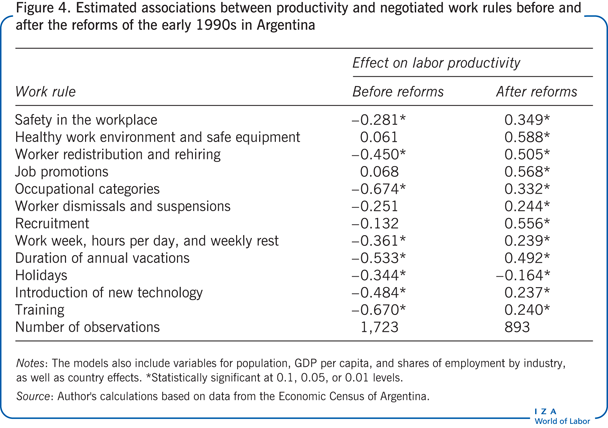
Limitations and gaps
Empirical studies have limitations in several dimensions. First, collecting accurate statistics on the coverage rates of collective bargaining agreements is difficult. Some countries report the number of employees affected by the terms of collective bargaining agreements in their first year, because the contracts are in effect until they are renegotiated or terminated, which could be several years later. Sometimes, working conditions are stipulated by several contracts simultaneously, creating measurement problems associated with data collection, or high-level bargaining units are misinformed about the number of employees affected by the agreement.
In addition, there are problems of comparability across countries because of the wide difference in collective bargaining institutions in each country. Moreover, the types of analyses that have been conducted cannot rule out the possibility that the results showing increases in productivity are associated with other variables that are not fully captured in the analysis. The literature is mostly silent on the specific channels through which union practices affect both total factor productivity—a variable which accounts for effects in total output not caused by traditionally measured inputs of labor and capital—and labor productivity. These limitations are all due to the lack of suitable data.
An also relevant, yet understudied topic in developing countries is the employers’ side of collective bargaining. Employer organizations typically include national federations of employers, specialized organizations representing employers in a particular segment of an industry, and local associations of employers representing local interests. It is often argued that many of these organizations in developing countries only weakly represent employers and their interests. While the number of employer associations has been declining in developed countries (for example, by 33% in the UK from 1979 to 1994), little is known about trends in developing countries. If representation of employers is weak or otherwise inadequate, that would affect the coverage and outcome of collective bargaining.
Summary and policy advice
There are large differences in the institutions and outcomes of collective bargaining across developing countries. In some countries, unions have not been active bargaining agents because of disruptions to the democratic process. In other countries, wages have received more attention than work practices in negotiations and ultimately in collective bargaining agreements because of the economic disturbances caused by bouts of moderate and high inflation. As is the case in developed countries, collective bargaining does not follow a single model across all developing countries. That can make analysis more difficult because the variations are likely to be associated with the way local labor market institutions are shaped by local economic conditions. One way around some of the problems is to focus on developing countries where collective bargaining institutions have changed greatly within a short period of time.
Because collective bargaining and economic conditions vary widely across developing countries, generalizations about appropriate policy prescriptions are difficult to make. However, some lessons may be drawn from the evidence for Argentina, a country with high coverage rates where policy reforms in the early 1990s weakened industry-wide bargaining. Argentina’s experience suggests that policies to promote decentralization of collective bargaining negotiations between firms and unions can advance labor productivity. In contrast, work practices bargained at higher national or industry-wide levels that include binding norms for agreements negotiated at lower levels appear to restrict economic efficiency.
Acknowledgments
The author would like to thank two anonymous referees and the IZA World of Labor editors for many helpful suggestions on earlier drafts. The author is also thankful to Robert Hartley for comments.
Competing interests
The IZA World of Labor project is committed to the IZA Guiding Principles of Research Integrity. The author declares to have observed these principles.
© Carlos Lamarche
